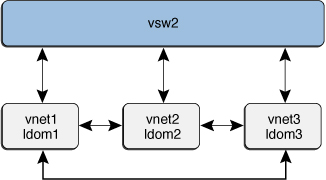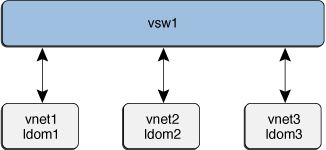Inter-Vnet LDC Channels
By default, the Logical Domains Manager would assign LDC channels in the following manner:
-
An LDC channel would be assigned between the virtual network devices and the virtual switch device.
-
An LDC channel would be assigned between each pair of virtual network devices that are connected to the same virtual switch device (inter-vnet).
The inter-vnet LDC channels are configured so that virtual network devices can communicate directly to achieve high guest-to-guest communications performance. However, as the number of virtual network devices in a virtual switch device increases, the number of required LDC channels for inter-vnet communications increases quadratically.
You can choose to enable or disable inter-vnet LDC channel allocation for all virtual network devices attached to a given virtual switch device. By disabling this allocation, you can reduce the consumption of LDC channels, which are limited in number.
Disabling this allocation is useful in the following situations:
-
When guest-to-guest communications performance is not of primary importance
-
When a large number of virtual network devices are required in a virtual switch device
By not assigning inter-vnet channels, more LDC channels are available for use to add more virtual I/O devices to a guest domain.
Note:
If guest-to-guest performance is of higher importance than increasing the number of virtual network devices in the system, do not disable inter-vnet LDC channel allocation.You can use the ldm add-vsw and the ldm set-vsw commands to specify a value of on, off, or auto for the inter-vnet-link property.
By default, the inter-vnet-link property is set to auto, which means that inter-vnet LDC channels are allocated unless the number of virtual networks in a particular virtual switch grows beyond the default maximum limit specified by the ldmd/auto_inter_vnet_link_limit SMF property. The default ldmd/auto_inter_vnet_link_limit value is 8. If more than the maximum number of virtual networks are present for a virtual switch, the inter-vnet LDCs are disabled. See Determining What Networks Are Present in Logical Domains.
If binding a guest domain or adding virtual networks to a bound domain results in the number of virtual networks in the virtual switch exceeding the limit, the inter-vnet LDCs are disabled automatically. The reverse is true. If unbinding a guest domain or removing virtual networks from a bound domain results in the number of virtual networks in a virtual switch being less than the limit, the inter-vnet LDCs are enabled automatically.
When inter-vnet-link=auto, the ldm list output shows the value as on/auto or off/auto depending on the active state of inter-vnet LDC channels for the virtual switch.
The following figures show typical virtual switch configurations when inter-vnet-link=on and inter-vnet-link=off, respectively.
The figure titled Virtual Switch Configuration That Uses Inter-Vnet Channels shows a typical virtual switch that has three virtual network devices. The inter-vnet-link property is set to on, which means that inter-vnet LDC channels are allocated. The guest-to-guest communications between vnet1 and vnet2 is performed directly without going through the virtual switch.
This figure also represents the case where inter-vnet-link=auto and the number of virtual networks connected to the same virtual switch is less than or equal to the maximum value set by the ldmd/auto_inter_vnet_link_limit SMF property.
Virtual Switch Configuration That Uses Inter-Vnet Channels

The figure titled Virtual Switch Configuration That Does Not Use Inter-Vnet Channels shows the same virtual switch configuration with the inter-vnet-link property set to off. The inter-vnet LDC channels are not allocated. Fewer LDC channels are used than when the inter-vnet-link property is set to on. In this configuration, guest-to-guest communications between vnet1 and vnet2 must go through vsw1.
This figure also represents the case where inter-vnet-link=auto and the number of virtual networks connected to the same virtual switch exceeds the maximum value set by the ldmd/auto_inter_vnet_link_limit SMF property.
Note:
Disabling the assignment of inter-vnet LDC channels does not prevent guest-to-guest communications. Instead, all guest-to-guest communications traffic goes through the virtual switch rather than directly from one guest domain to another guest domain.Virtual Switch Configuration That Does Not Use Inter-Vnet Channels

For more information about LDC channels, see Using Logical Domain Channels.